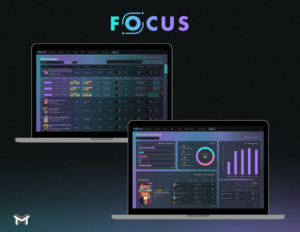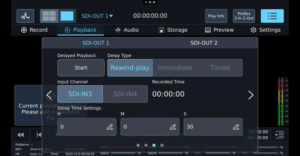June 2024
MediaTech Radar is a monthly newsletter put together by IABM’s Business Intelligence Unit. It focuses on a spotlight topic in MediaTech and reflects on a series of past, present, and future business developments in the industry. In this edition, our spotlight topic is Talent Shortages in MediaTech, the first report published in our new Megatrend research series, to be followed later this year by ESG: Tangible Sustainability, Supply Chain and Democratization Megatrend reports.
MediaTech Spotlight: Talent Shortages in MediaTech
A spotlight topic in MediaTech.
Our first Megatrend report, Talent Shortages in MediaTech, is based on extensive research combining data from our talent survey, a wide range of expert interviews and a literature review. The report covers a broad spectrum of topics including recruitment, competition for technical talent, pay and working conditions, strategy implementation, education and training, the impact of AI, collaborative initiatives and actionable recommendations for effectively tackling talent shortages. Regional variations in the MediaTech talent market, including challenges and solutions tailored for each region, are also explored in detail. Below, we have included a selection of insights from the report:
- Talent shortages in MediaTech are caused by a range of factors including rapid changes in technology and convergence with other sectors increasing competition for technical talent.
- Shortcomings in education and training, salary differentials and challenging working conditions are also contributing to talent shortages.
- Limited awareness of career opportunities and entry pathways into MediaTech is also contributing to talent shortages. Educational initiatives, industry partnerships and outreach programs can help increase this awareness.
- Partnerships with educational establishments help to ensure that courses are kept up to date and align with the technical skills needed by the industry.
- Companies can improve employee retention by fostering a positive working environment that includes flexible arrangements and career development opportunities and establishing policies to tackle unacceptable workplace behavior.
- Industry collaboration to develop mentorship networks, industry-driven internships, apprenticeship schemes and open learning resources can help secure a pipeline of technical talent into the sector.
- The sector needs to reach out more to underrepresented groups through collaborative Diversity, Equity and Inclusion initiatives and work to ensure that opportunities for training, development and support are made available to as many people as possible.
MediaTech Watchlist: Super aggregation, Netflix hits record in ad space, 5G goes public cloud
A watchlist of selected past, present and future business developments in MediaTech.
- In early May, Walmart introduced its first hybrid streaming device, the Onn. 4K Pro, built on Google TV platform. The launch of the device consisting of a streaming box and a smart speaker – only priced at $49.9 – follows Walmart’s announcement about its plan to acquire a smart TV manufacturer Vizio for about $2.3 billion earlier this spring. Over the past 12 months, Walmart has systematically built its bridge to the streaming space through partnerships with major streaming services. The launch of its own streaming device makes Walmart leap forward in its media strategy, which increasingly resembles that of a super aggregator.
- In May, Apple introduced several upgrades to its Final Cut Pro software that enables iPad to be used as a live multi-camera production studio, allowing the user to connect and preview up to four cameras at once in one place. Apple also announced new AI features that will be coming to Final Cut Pro later this year. Apple’s upgrades are good news for the creator community as well as rapidly growing adjacent markets such as Pro AV and corporate sectors increasingly producing high-quality video content.
- In May, Roku bought the exclusive multi-year rights for MLB Sunday Leadoff live games, which will be streamed for free on The Roku Channel. Roku will also launch an MLB Zone aggregating information about live and upcoming games, highlights, recaps and an MLB FAST channel. Charlie Collier, President at Roku Media said: “As television programming, live sports and the leagues have fragmented across networks, apps and multiple packages, Roku – home to all of them – plays an increasingly crucial role for viewers and advertisers.” Fragmentation of sports rights and CTV services are leading to the emergence of bundled super aggregators, increasingly re-monetizing content on FAST channels.
- Another interesting example of bundled super aggregation is Comcast’s announcement to start offering a new StreamSaver streaming bundle of Netflix, Peacock and Apple TV+ at a reduced price. Earlier in May, Warner Bros. Discovery and Disney announced their new streaming bundle combining Disney+, Hulu and Max, becoming available this summer. As the US’ streaming market continues to mature, streamers and Pay-TV operators are increasingly entering re-bundling initiatives and content partnerships to address subscription fatigue and high streaming bills, both being major reasons for subscriber churn.
- In May, Netflix announced that the number of monthly active users (MAUs) of its ad-supported plan jumped from 5 million to 40 million year over year. Netflix also introduced its plan to launch an in-house advertising technology platform in Q4 2025. Amy Reinhard, President of Advertising at Netflix said: “Bringing our ad tech in-house will allow us to power the ads plan with the same level of excellence that’s made Netflix the leader in streaming technology today.” By moving to ad-supported streaming, the company aims at improving profitability and diversifying its revenue streams.
- At the end of May, Nvidia reported a record high Q1 2024 revenue, up by 262% from the previous year thanks to global investment boom in AI and orders for Nvidia’s latest GPU super chip launched earlier this year.
- In June, Nokia and O2 Telefonica announced that they had entered a partnership with Amazon to deploy 5G standalone core software on Amazon Web Services in Germany, making them the world’s first mobile operators shifting their core network to a public cloud. In February 2024, Japan’s NTT DOCOMO also announced plans to deploy its 5G Open RAN network in partnership with AWS. Moving the core network from servers in data centers to a public cloud, mobile operators can scale and allocate 5G network capabilities dynamically based on demand, saving costs without compromising quality and latency – this is increasingly crucial for telcos as mobile traffic continues to skyrocket.
Thank you for reading this newsletter. If there are topics you would like us to cover or have information/ideas you’d like to share, please get in touch with us.
The IABM Business Intelligence Unit









